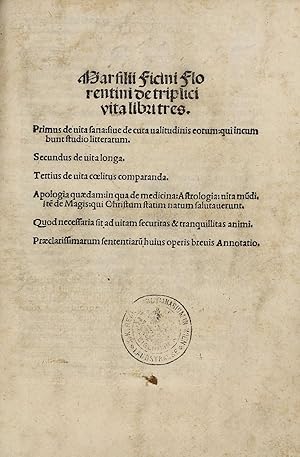Riguardo questo articolo
27. May 1501. 4to (205 x 137 mm). 3 parts in one volume. 118 unnumbered leaves, including index and end and final blank leaf C6. Signatures: (a-z)4 &4 [revc]4 [rum]4 (A-B)4 C6. Latin text in Roman type, with Gothic title. Imprint from colophon on A4v reading "Bononie a Benedicto Hectoris. MCCCCCI. Die. XXVII. Mai." Contemporary blind-stamped calf over wooden boards with single brass catch, spine with 3 raised bands (clasp gone, leather heavily rubbed spine ends chipped showing capital bands). Fore-edge of book block titled in manuscript. Title little browned and soiled, otherwise crisp and clean with only very little toning or spotting, two pages with finger soiling to lower right corner, short closed tear to k3. Provenance: K. K. Real- u. Obergymnasium Wien, Landstrasse (19th century ink stamp to title and C5r). A handsome, clean and wide-margined copy. Collated complete. ---- Wellcome I, 2258; Durling 1540; Simon BB II 246; ISTC if00161000. - THE FIRST POST- INCUNABLE EDITION and textual identical with the 1498 Venice edition. Ficino's Neoplatonic treatise on longevity, De triplici vita, was first published in Florence in 1489. Ficino, who studied medicine in his youth (his father was a physician to the Medici), here combines the principles of nutritional and physical care with emotional and spiritual wellbeing, including the use of amulets and attention to astrological factors. Although his treatise came under scrutiny by the Holy Office, Ficino claimed that he was quoting from earlier writers rather than expounding his own opinions. The colophon includes verses by Amerigo Corsini stating that Filippo Valori paid the expense of publication. "Of the three Books of De Triplici Vita the first deals with preserving the health of scholars, the second with prolonging their life, and the third with astral influences on them. Through all three, Ficino's attention is devoted not so much to man's soul or body as to his spiritus.The De Triplici Vita is presented as a medical treatise, and the practices recommended in it might be taken as somewhat odd medical remedies and regimes-odd only because of the large place given to talismans and music; for there is, of course, nothing odd in a Renaissance medical treatise dealing with spirits and astrology. . . It is clear that Ficino is strongly attracted by this kind of magic or theurgy, that he considers valuable, and also it is clear that he is aware that it is dangerous. His conclusion seems to be that its dangers might be avoided if it remained within a learned, philosophical circle, and were kept secret from the ignorant vulgus, who would distort it into idolatry and superstition." D.P. Walker, Spiritual And Demonic Magic From Ficino To Campanella. - Visit our website for additional images and information. Codice articolo 002977
Contatta il venditore
Segnala questo articolo
![]()




